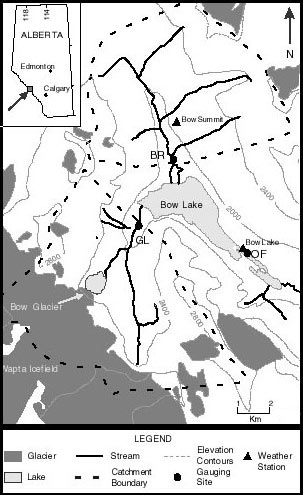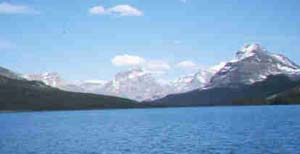 Alberta's WaterIntroductionPublications Climate Change Industrial Impacts Agricultural Impacts Urban Impacts Biodiversity Loss Definitions Links Site Map |
 |
|
 |
| Map of Bow Lake. GL and BR show the gauging stations, while the meteorological station is marked by an OF. An Environment Canada Weather Station is also present at Bow Summit. |
Subsequent investigations by Campbell and others in 2000 showed that the elevated levels of contaminants in fish from Bow Lake could not be explained by biomagnification, the increased concentration of pollutants at higher levels in the food chain. Dr. Kidd and others showed, however, that in lower elevation lakes biomagnification does explain fish contaminant levels.
Research in 1993 determined that trout from Bow Lake have higher levels of organochlorines than any other trout in western Canadian lakes.
Studies by Dr. Blais and others from the University of Alberta (Drs. Schindler, Sharp, Lafrenière, and Eric Braekevelt) determined that glacial runoff was the dominant source of OC inputs to Bow Lake, and that most OCs from this source were in the dissolved phase and hence were highly bioavailable, or available for uptake by organisms. Further research by Melissa Lafrenière, was conducted to determine why glacial runoff is a major source of OC contaminants.
 |
| South view of Bow Lake, Banff National Park. |



 Hydrological and hydrochemical investigations in a glacial lake catchment: implications for organochlorine transport
Hydrological and hydrochemical investigations in a glacial lake catchment: implications for organochlorine transport